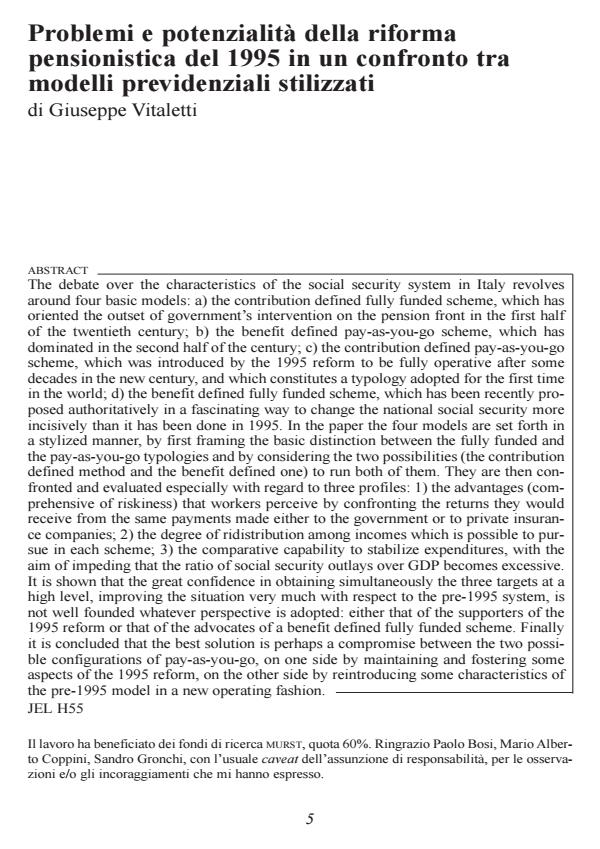Problemi e potenzialità della riforma pensionistica del 1995 in un confronto tra modelli previdenziali stilizzati
Journal title ECONOMIA PUBBLICA
Author/s Giuseppe Vitaletti
Publishing Year 1 Issue 2000/4
Language Italian Pages 48 P. File size 157 KB
DOI
DOI is like a bar code for intellectual property: to have more infomation
click here
Below, you can see the article first page
If you want to buy this article in PDF format, you can do it, following the instructions to buy download credits

FrancoAngeli is member of Publishers International Linking Association, Inc (PILA), a not-for-profit association which run the CrossRef service enabling links to and from online scholarly content.
The debate over the characteristics of the social security system in Italy revolves around four basic models: a) the contribution defined fully funded scheme, which has oriented the outset of government’s intervention on the pension front in the first half of the twentieth century; b) the benefit defined pay-as-you-go scheme, which has dominated in the second half of the century; c) the contribution defined pay-as-you-go scheme, which was introduced by the 1995 reform to be fully operative after some decades in the new century, and which constitutes a typology adopted for the first time in the world; d) the benefit defined fully funded scheme, which has been recently proposed authoritatively in a fascinating way to change the national social security more incisively than it has been done in 1995. In the paper the four models are set forth in a stylized manner, by first framing the basic distinction between the fully funded and the pay-as-you-go typologies and by considering the two possibilities (the contribution defined method and the benefit defined one) to run both of them. They are then confronted and evaluated especially with regard to three profiles: 1) the advantages (comprehensive of riskiness) that workers perceive by confronting the returns they would receive from the same payments made either to the government or to private insurance companies; 2) the degree of ridistribution among incomes which is possible to pursue in each scheme; 3) the comparative capability to stabilize expenditures, with the aim of impeding that the ratio of social security outlays over GDP becomes excessive. It is shown that the great confidence in obtaining simultaneously the three targets at a high level, improving the situation very much with respect to the pre-1995 system, is not well founded whatever perspective is adopted: either that of the supporters of the 1995 reform or that of the advocates of a benefit defined fully funded scheme. Finally it is concluded that the best solution is perhaps a compromise between the two possible configurations of pay-as-you-go, on one side by maintaining and fostering some aspects of the 1995 reform, on the other side by reintroducing some characteristics of the pre-1995 model in a new operating fashion.
Giuseppe Vitaletti, Problemi e potenzialità della riforma pensionistica del 1995 in un confronto tra modelli previdenziali stilizzati in "ECONOMIA PUBBLICA " 4/2000, pp , DOI: